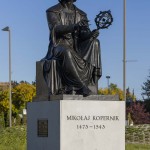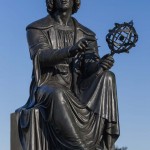

Bertel Thorvaldsen was born in Copenhagen in 1770 and entered the Royal Danish Academy of Sculpture when he was 11 years old. He graduated with the Academic Prize. He then moved to Rome, where he lived for 10 years. He began to become well known in 1812, when he produced Alexander the Great’s Entry into Babylon for one of the halls in the Quirinal Palace, the papal summer residence. He was now assured glory and wealth, and his list of commissions grew constantly. He returned to Denmark in 1819. His studio then became a factory, and he was so successful that during his lifetime Denmark created a museum bearing his name and devoted to his work. He died in Copenhagen in 1844.

Artwork description
This artwork is a copy given to Montréal of a first posthumous impression made from the plaster original of a statue of Nicolas Copernicus conserved at the Thorvaldsen Museum. In 1973, to celebrate the 500th anniversary of Copernicus’s birth, the city of Chicago received a copy of the work by Danish sculptor Bertel Thorvaldsen, which was placed outside the city’s planetarium. Thorvaldsen had made the original in 1822; the following year, the statue was installed facing the Academy of Sciences in Warsaw. In 1944, the Germans removed it from its base and eventually abandoned it in a village in Silesia. Found by the Allies after the war, it was returned to its original site.
To give his statue an authentic face, Thorvaldsen was inspired by copies made of two self-portraits painted by Copernicus. His figure, who is exercising the functions of canon, wears a hair style and clothing common in Poland during the period. When he had a break from his many ecclesiastic duties, Copernicus, above all a scholar, mathematician, and astronomer, devoted himself to observation and research. His position and the instruments that he is holding testify to this: on one side, a spherical astrolabe, a model based on the solar system, and on the other, an open set of compasses, emblem of the hard sciences and mathematical rigour.



